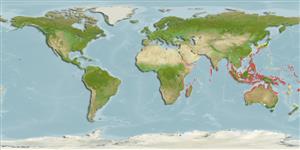Common names from other countries
Environment: milieu / climate zone / depth range / distribution range
Ecología
; rango de profundidad 1 - 3 m (Ref. 101250). Tropical
Western Central Atlantic and Western Pacific: Red Sea.
Length at first maturity / Tamaño / Peso / Age
Maturity: Lm ? range ? - ? cm Max length : 9.4 cm SHL macho / no sexado; (Ref. 122460)
Found in shallow subtidal (Ref. 3204) up to possibly 100 m for juveniles (Ref. 98471). Inhabits sandy coral reef and shallow bays, hiding underneath rocks and dead corals (Ref. 98471), in shallow waters and intertidal shores (Ref. 128042). Feeds on fish and polychaetes (Ref. 3204).
Life cycle and mating behavior
Madurez | Reproducción | Puesta | Huevos | Fecundidad | Larva
This species is a non-broadcast spawner. Life cycle does not include trocophore stage. Also Ref. 833.
Rosenberg, G. 2005. (Ref. 3446)
IUCN Red List Status (Ref. 130435)
CITES status (Ref. 108899)
Not Evaluated
Not Evaluated
Threat to humans
Human uses
Pesquerías: de interés potencial
| FishSource |
Herramientas
Más información
Age/SizeCrecimientoLength-weightLength-lengthMorfologíaLarvaAbundancia
Fuentes de Internet
Estimates based on models
Preferred temperature
(Ref.
115969): 24.8 - 29.3, mean 28.5 (based on 2297 cells).
